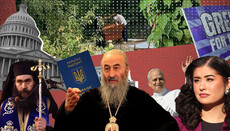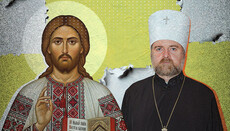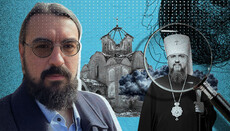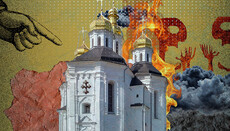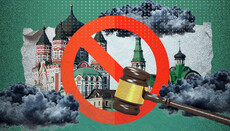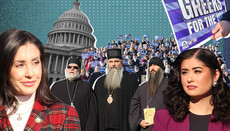They can’t get enough of Little Sophia: How UGCC and OCU divide Kiev Sophia
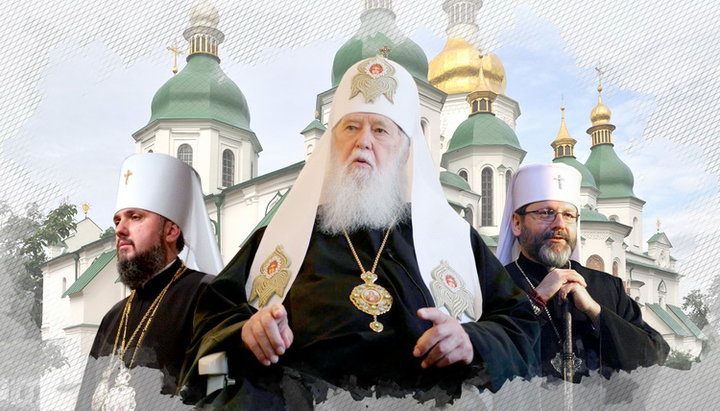
Why is it so important for Uniates to hold a service at St. Sophia's of Kiev and who or what stands in their way?
Ukraine is a multiethnic and multi-confessional state. Attempts to redraw the religious map of the country, especially towards the unity of the Orthodox and Catholics, were made long ago and did not lead to anything good.
In one of the lectures, Ivan Ogienko, the well-known historian of Ukraine, spoke about the union policy of the Polish state (which also included part of modern Ukraine) as follows:
“These consequences (of the union for Ukraine – Ed.) were terrible. These were the implications that I call deadly. <...> The Orthodox Church carried strength to Ukraine, and the union broke it. The Union ruined our Church around, the union broke (the conventional canon) and this weakened our Orthodox Church, brought about discord and disorder. <...> The Uniates enrolled of all those who were excommunicated (priests banned in the Orthodox Church – Ed.) and this caused disorder in the Church <...>. The church discipline was spoilt.
The worst priesthood passed over to the Uniate Church ... The Church was decomposed, the Church was losing strength, and since Ukraine was connected with the Orthodox Church, Ukraine itself was also losing strength. It affected everyone hard. <...>
When the priest did not want to accept the union, they resorted to all sorts of oppression and the clergy fell into disrepair. Therefore, when we are often told that Orthodox priests went to the union in order to avoid the disorder in their Church, this is absolutely untrue, because the Catholic Church created this disorder for us, the very first monger being the Uniate. <...>
The Brest Union affected Ukraine politically. <...> The Union depleted Ukraine altogether, and it began as early as the Union of Florence in 1439. Since the Union of Florence was born, it castigated the Ukrainian people, while the Brest Union twisted the knife. <...> The people understood well that the Orthodox faith and the Ukrainian nation are inextricably linked, and therefore, defending the faith, they defended themselves. The Uniates were not tied to Ukraine, among the whole Uniate episcopate we do not see any Ukrainian patriots, and they did not need Ukraine.”
Eastward via Kiev
In the end, after the uprising of Bogdan Khmelnitsky and the accesssion of the greater part of Ukraine into the Moscow state, the Uniates' attempts to bring the Ukrainians into unity with the "Holy See" of Rome somewhat abated.
Theses attempts resumed after Ukraine had become an independent state. In the 1990s, the seizure of temples in Lvov, Ternopol, and Ivano-Frankovsk regions became commonplace. At present, the Greek Catholics declared themselves virutally the only patriots of Ukraine, created a whole chain of radical organizations against the Orthodox Church, and with the help of the authorities did what they could not do 300 years ago. Aggression, anger and intolerance have become the hallmarks of a large number of the UGCC representatives in Western Ukraine.
However, the Uniates never abandoned their plans for the east. Almost two years ago, the head of the UGCC, Sviatoslav Shevchuk, called on his parishioners: “Let's go eastward! For the future of the UGCC and Ukraine is forged where war is waged and people are afflicted.”
“The people understood well that the Orthodox faith and the Ukrainian nation are inextricably linked, and therefore, by defending the faith they defended themselves.”
Historian Ivan Ogiyenko
Let’s leave aside the question of why the Uniates are so attracted to the war and the whole nine yards and pay attention to a different thing – to Kiev.
After all, it is completely obvious that the “movement to the east” is simply unthinkable unless you include Kiev, “the mother of Rus cities” in its route. Moreover, as Sviatoslav Shevchuk has repeatedly stated, the UGCC emerged from the same baptismal font as the “other Churches” of Ukraine: “The UGCC is the Church that was born from the baptismal font of St. Vladimir the Great in 988 ... Unlike other Ukrainian Churches, the daughters of St. Vladimir baptism, we have always kept in touch with the successor of the Apostle Peter, especially from 1595, when our bishops gathered in Brest to sign a decree that confirmed their communion with the Bishop of Rome and then with the whole Universal Church.”
For the Uniates, their spiritual presence in Kiev is evidence that the path of complete elimination of the Orthodox Church, along which they are walking, will lead them to final victory. It is like a symbol of the new “baptism” of Rus, though the baptism under the omophorion of the Pope of Rome, rather than the Orthodox patriarch.
St. Sophia Cathedral of Kiev and St. Paul Cathedral
Therefore, having a “worship” in the most ancient church of Ukraine, St. Sophia of Kiev, is of such great importance to Uniates. In a specially published letter “Our Holy Sophia”, Sviatoslav Shevchuk emphasizes that “the Cathedral of Saint Sophia remains a faithful witness to the baptism of unity of the Kiev Church, consecrated with this grace, which, being in full communion with the ancient Churches of Rome and Constantinople, became for us the right path to the universal brotherhood Christian nations. Upon that a special ecumenical vocation of our Church is revealed – a witness of undivided Christianity and a martyr of our time.”
One must admit that the text of this message more than eloquently testifies to the role that the Catholics and Uniates took to Ukraine for the full and unconditional "unity" of the Orthodox with the "Apostle of Rome."
Moreover, many Orthodox experts have already noted that the newly created OCU will most likely work hand in hand with the Uniates in their “ecumenical aspirations”.
It was not the first time for Greek Catholics to pretend to penetrate into the Kiev Sofia by any means. Back in 2016, Sviatoslav Shevchuk appealed to the Ministry of Culture of Ukraine with a request to allow alternate divine services in the so-called “Little Sofia” church attached to the “St. Sophia of Kiev” reserve, which was granted to the Kiev Patriarchate by the order of the authorities.
“The UGCC is the Church, which was born from the baptismal font of St. Vladimir the Great in 988 year.”
UGCC leader Sviatoslav Shevchuk
However, then the “patriarch” Filaret was dead-set against this initiative. He stated his position in an official letter, in which he emphasized that “the above church had never belonged to the jurisdiction of the UGCC and this Church had never performed divine services in it. The prospect of establishing such alternate worship services will inevitably lead to raising similar questions regarding the issue of alternate worship services of the communities of the Kiev Patriarchate and the UGCC both in the temples belonging to the communities of the Kyiv Patriarchate and in those belonging to the UGCC communities, in particular in the Cathedral of Saint Yura in Lvov and in other outstanding temples, where in different historical periods both Orthodox and Greek-Catholic communities used to have divine services. Given that the UGCC has its own grand cathedral in Kiev and also the complexity of the issue of alternate worship services between Orthodox and Greek Catholic communities, which are painful for both sides due to the past history, we prefer to preserve the current order of worship in the holy church of Prince Yaroslav the Wise – Little (Warm) Sofia – and not to make any corrections.”
This ultimatum letter of Filaret produced the proper effect on the government and the question of alternate service was no longer raised.
A symbol of unity or discord?
The issue of belonging arose again with the new force when spokesman of the Verkhovna Rada, Andrei Paruby (also a Uniate, as well as the head of the Ministry of Culture Yevgeny Nishchuk) declared on December 3, 2018 that it was necessary to discuss that St. Sophia Cathedral had to become the main temple of the “New Local Orthodox” (current OCU).
There was no discussion, since Sviatoslav Shevchuk had already categorically opposed it saying that the church of St. Sophia of Kiev was a common shrine not to be placed at the disposal of one “Church of the Vladimir Baptism”.
However, after a few days, Epiphany Dumenko, the head of the OCU, particularly emphasized that St. Sophia had to become the Cathedral of “One Church”: “We believe that this historic Metropolitan Cathedral of Kiev will serve in the future as the official Cathedral for the primate of the United Local Orthodox Church. This is a historical truth. We must use this shrine for prayer. It was built as a temple so that prayers would be offered in the temple. And apparently, on major church holidays and on major historical holidays of the Ukrainian people, we will hold services in this particular historic Kiev Metropolitan Cathedral.”
Naturally, such a position of Epiphany forced the Ukrainian Uniates to take countermeasures. One of them was Shevchuk's announcement that on April 7, the “worship” of UGCC representatives would take place in the main shrine – Saint Sophia of Kiev.
Moreover, Shevchuk announced the All-Ukrainian “pilgrimage” of the Uniates to this majestic and ancient temple. On February 17 he said, “I want to share with you joy. At our request, this week I received a message from the Minister of Culture of Ukraine Yevgeny Nishchuk that on April 7, on the feast of the Annunciation, we will be able to hold a divine liturgy at St. Sophia in Kiev. Therefore, I cordially invite all of you to join this event. <...> We will do everything possible so that we all could decently participate in this divine liturgy! Therefore, I solemnly proclaim the pilgrimage of our entire Church to St. Sophia in Kiev this year on April 7.”
Filaret is disaffected
Selecting this particular date for “worship” is not accidental, since exactly on April 7, 2019 there will be celebrated ten years from the day of Sviatoslav Shevchuk’s “episcopal ordination”. Therefore, it is not surprising that on the same day, after the end of the festive "worship", a festive dinner would be offered for guests of the UGCC head in the Metropolitan's Chambers of St. Sophia of Kiev, in the very ones where the first OCU "synod" was held in December.
But again, Filaret took the initiative and addressed the UGCC head Shevchuk with a message. The leader of the Ukrainian schismatics stressed that the desire of the Uniates to serve the liturgy in St. Sophia can be compared with "as if someone from the Orthodox primates performed a divine liturgy in the Cathedral of the Holy Apostle Peter in Rome."
He assured the head of the UGCC that such an initiative would surely encounter resistance among Orthodox believers and could be used by Russia for a new round of inter-religious confrontation in the country:
“We are concerned about this anticipated event, which could cause confrontation between Orthodox and Greek Catholics and disrupt an interfaith dialogue in Ukraine. At a time when there is a war for the independence and integrity of Ukraine in the east of our state, we are called to testify and maintain peace and unity in society. There is a danger that Russia can use this situation to carry out provocations in order to harm the Ukrainian people.
We want to continue to maintain good relations between the Ukrainian Orthodox Church and the Ukrainian Greek Catholic Church that have developed between us over the past decades.
Having a desire to avoid interfaith tensions, we ask you to abandon the idea of organizing the pilgrimage and the Divine Liturgy in St. Sophia of Kiev.”
Filaret's statement can be interpreted as an ultimatum, which he put forward to Greek Catholics. It should be understood as a warning to the authorities that such an initiative of the Uniates can end badly. Naturally, every blame can be shifted to Moscow, as it is usually done, but it will become clear to everyone one can give up on the peace between the UGCC and the OCU.
Such a tough and irreconcilable position of Filaret forced the Ministry of Culture to reconsider its permission to hold the “worship”, and on February 23 they said that such events harm the national monument of universal significance like St. Sophia and they had did not given any permission to anyone to perform a divine worship .
And this is where the main question arises – what is actually going on? Indeed, in the light of the statements of Shevchuk that “Eucharistic communion with the OCU is our sanguine prospect” and that “Our common goal is the creation of a single Kiev Patriarchate”, such an intransigent position of Filaret looks strange, to say the least.
Moreover, the OCU itself speaks up that they are “Sister Churches” with the Uniates, while the idea of integrating the OCU and the UGCC is fully backed by Phanar. Bishop Daniel of Pamphilon has recently declared, “I am sure that this (unity – Ed.) is quite possible. Their spiritual predecessor fathers, Vladyka Andrey Sheptitsky, Joseph Slipy and other hierarchs repeatedly said that when the Orthodox Church of Ukraine has got its own identity, the Greek Catholics will have to find a way to unity with this Church.”
“I am sure that this (unity of OCU and UGCC – Ed.) is quite possible.”
Bishop Daniel of Pamphilon
However, as we see, the formidable figure of the “honorable patriarch” stands in the way to this unity. Why?
To answer this question, you need at least a little to know Filaret. This is a man who all his life has sought and seeks to become a patriarch. He sees himself as the head of the “Ukrainian Church,” and it was he and his “Church,” he said, that President Petro Poroshenko brought Tomos. Yes, Epiphany is ostensibly the head of the OCU. However, as Filaret himself has repeatedly stressed, the head is purely nominal, external. This means that, in the understanding of Mikhail Denisenko, all relations between the “Sister Churches” should be built via him – the “honorary patriarch”, and not via his pupil.
But from the very beginning of the existence of a new structure called OCU, the Greek Catholics have defiantly ignored Filaret. All greetings, letters, etc. from Sviatoslav Shevchuk are sent to Epiphany personally. Neither does Filaret take part in negotiations and meetings. And even concerning the “divine service” in St. Sophia, the UGCC press service stated everything would be resolved at a personal meeting of the heads of the two Churches, Epiphany and Sviatoslav.
Apparently, the Ukrainian Uniates received “recommendations” from the Vatican that it was necessary to rely on the young “metropolitan” and not on the old “patriarch”. Perhaps, Epiphany received similar instructions from his leadership. As a result, we have a situation in which Filaret is gradually sliding into the background of the religious life of Ukraine. “The Moor has done his duty, let him go”...
There is no doubt that Filaret will never forgive such disregard toward his figure. And for some time we will witness a serious struggle between him and all the others. Rather, the struggle will be only on the one side because the standpoint of the other is utterly clear – Filaret has done his part and can be discarded. How wrong they are! Despite his age and the position that he occupies now, Mikhail Denisenko has not yet said his last word. And the inconveniences he may cause for his offspring may eventually destroy the offspring itself or finally demonstrate its inconsistency, both in Ukrainian society and in the eyes of those Local Orthodox Churches that have not yet officially declared against the OCU. In this case Moscow will definitely have nothing to do with it.
